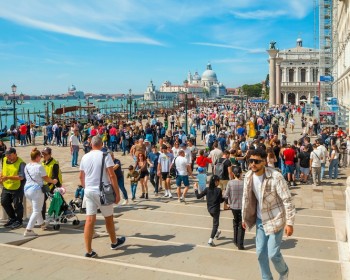An Unexpected Spectacle
The minor islands represent, therefore, one of the best, yet unexpected, keys to understanding the traditions, culture, and architecture of Venice and the surrounding area, away from the chaos of the historic center and the most popular destinations. Moreover, reaching them is very easy because almost all of them are accessible by the public boat network. Below, we list some of the "hidden gems" of the lagoon that we recommend visiting during your stay in Venice.
San Michele Island
San Michele is located between Venice and Murano. The name originates from the church dedicated to the Archangel Gabriel, which stands on the island. Since 1807, it has been home to the monumental cemetery of Venice, where the tombs of illustrious figures such as Ezra Pound and Stravinsky are located. A curiosity about this small territory surrounded by the sea: it consists of two islands, San Michele and San Cristoforo della Pace, which in 1829 were united by burying the narrow channel that separated them to allow for the expansion of the cemetery. It can be reached by ACTV vaporetto lines 4.1 or 4.2.
San Giorgio Maggiore Island
It stands in front of St. Mark's Square. Here, you will find the Basilica of San Giorgio Maggiore and the Benedictine monastery, which was one of the major European centers in theological and cultural fields. In addition to these two religious centers, the island is home to the Teatro Verde, an open-air amphitheater with an exceptional view of the lagoon. The island can be reached by ACTV vaporetto line 2 in 5 minutes from San Zaccaria.
San Servolo Island
The heart of this island is characterized by a beautiful park ideal for relaxing walks and a wonderful monumental complex that now houses a congress center and the Museum of the San Servolo Asylum, which collects artifacts belonging to the psychiatric hospital. The park is a green and relaxing oasis, perfect for pleasant outings. San Servolo can be reached by ACTV vaporetto, line 20, from San Zaccaria.
San Lazzaro degli Armeni Island
It is entirely occupied by a monastery, the mother house of the Mekhitarists, one of the most important centers of Armenian culture in the world. You can visit the gardens, the various rooms of the convent, including the library where numerous manuscripts are preserved, and the mummy of Nehmeket. It is reachable by ACTV vaporetto, line 20, from San Zaccaria.
Sant'Angelo della Polvere
A tiny island (less than half a hectare) located between Venice and San Giorgio in Alga. In the early 11th century, it was colonized by Benedictine nuns, who built a convent there. However, shortly after 1500, the nuns were forcibly expelled for a very curious reason that we will explain shortly. Once the religious women were driven away, the building was converted into a powder magazine. Hence the name Sant'Angelo della Polvere (Saint Angel of Powder). Like many of its "sister islands", this small piece of land in the middle of the lagoon has a very particular history. As we mentioned earlier, the island's first inhabitants were the nuns, who are linked to a story narrated in detail in the 16th-century chronicles. The wives of fishermen living on the islands of Pellestrina and Malamocco noticed a sharp decrease in fish catches. Unconvinced by their husbands' explanations, they commissioned a magistrate to investigate. The surveys revealed that the fishermen, upon their return, would stop at the island of Sant'Angelo, where they would leave part of their catch to the nuns in exchange for sexual favors. The scandal struck a Church already under attack (we must remember that the event occurred at the same time as the Lutheran Reformation of 1517), which immediately sought to rectify the behavior of the nuns. The intervention by the religious authorities led to no result, with the priests being pelted with stones and sent back to Venice. Guards were needed to remove the tempting sisters from the island. As evidence of this, oyster shells dating back to 1500 were found, a type of dish, then as now, particularly sought after and not present in the daily menu of the nuns of the time. The island is easily reachable by boat from Venice.
Pellestrina Island
Pellestrina Island is a narrow strip of land 10 km long between the lagoon and the sea, located between the Lido of Venice and Chioggia. It is characterized by low, colorful houses, with boats lined up along the shore. Pellestrina can be reached from the Lido of Venice, from piazzale S. Maria Elisabetta, in about 30 minutes, by ACTV bus line 11.
San Francesco Del Deserto Island
Near Burano, this tiny island houses a monastery and a beautiful park. It has been inhabited by the Franciscan Friars since around 1230. Tradition holds that Saint Francis passed through here in 1220. San Francesco del Deserto can be reached from Burano. Since there are no public transportation services from Burano to San Francesco del Deserto, it is necessary to contact the Laguna Fla Group Srl service.
Lazzaretto Nuovo
By decree of the Senate of the Most Serene Republic, it became a lazaretto with the task of preventing contagion during the terrible years of the plague. The island can be reached by ACTV vaporetto line 13, departing from Fondamente Nuove.
Lazzaretto Vecchio
Lazzaretto Vecchio is the first lazaretto in history, established by the Republic of Venice in 1423. Plague victims were transferred here after spending quarantine in Lazzaretto Nuovo. Visits to the island take place only on certain occasions. The island is not reachable by public transportation, and transportation is organized in conjunction with extraordinary openings.
Conclusion
These are just some of the lesser-known islands that surround Venice and are still unfamiliar to the general public; the list could indeed be even longer, but we leave you with a bit of mystery, inviting you to discover this archipelago that lies in the heart of the Venetian Lagoon.












